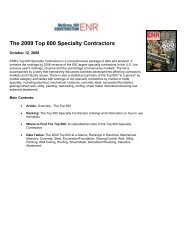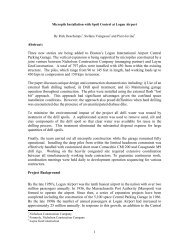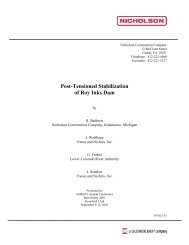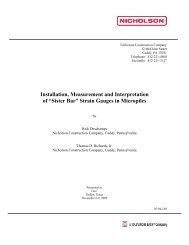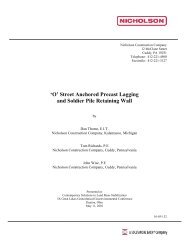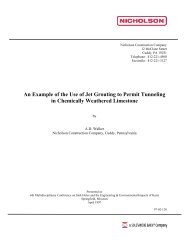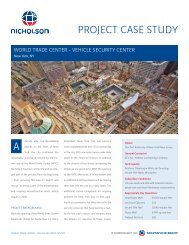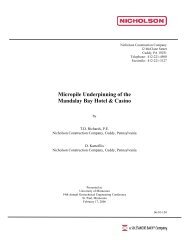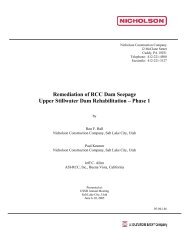Rehabilitation of a Failing Anchored Retaining Wall - Nicholson ...
Rehabilitation of a Failing Anchored Retaining Wall - Nicholson ...
Rehabilitation of a Failing Anchored Retaining Wall - Nicholson ...
You also want an ePaper? Increase the reach of your titles
YUMPU automatically turns print PDFs into web optimized ePapers that Google loves.
Richards/Thome, Page 1<br />
<strong>Rehabilitation</strong> <strong>of</strong> a <strong>Failing</strong> <strong>Anchored</strong> <strong>Retaining</strong> <strong>Wall</strong><br />
Thomas Richards, <strong>Nicholson</strong> Construction Company, Cuddy, PA USA<br />
Daniel Thome, <strong>Nicholson</strong> Construction Company, Kalamazoo, MI USA<br />
Abstract<br />
Significant movement to an existing diaphragm (slurry) wall on ‘O’ Street in Southeast<br />
Washington, D.C. was caused by failure <strong>of</strong> some anchors. Potential causes <strong>of</strong> failure are<br />
presented. <strong>Rehabilitation</strong> and stabilization for the failed wall was performed by demolishing<br />
the failed panels, drilling horizontal weep holes, constructing a new precast lagging and<br />
soldier pile wall in front <strong>of</strong> the existing structure, and improving site drainage system.<br />
Background<br />
In the late 1970s the District <strong>of</strong> Columbia decided that permanent stabilization <strong>of</strong> the slope<br />
was required due to the continuous slope movements toward ‘O’ Street. In 1978 an anchored<br />
slurry wall was constructed between ‘O’ Street and Highwood Drive to retain the earth from<br />
further movements.<br />
The anchored slurry wall consisted <strong>of</strong> fifty, 6.7 meter wide reinforced concrete panels<br />
designed to be embedded into a hard clay stratum. High strength threaded bar anchors were<br />
installed through the slurry wall and designed to be bonded into the hard clay. During<br />
construction the bearing plates to the ground anchors were reported to have been visually<br />
showing failure after they were stressed. Eventually the initial bearing plates were replaced<br />
with larger ones soon after construction. Corrosion protection was a tar like coating applied<br />
to the bearing plates and beveled nuts, and anchor heads after they were installed and stressed.<br />
In the winter <strong>of</strong> 1995 excessive ground movements were noted in approximately 46 meter <strong>of</strong><br />
the slurry wall. Ground movements were recorded on this particular section <strong>of</strong> the wall and<br />
continued until the spring <strong>of</strong> 1996 when eventually this section failed. Maximum deflections<br />
in the order <strong>of</strong> 4 meters downslope were recorded. Through time the ground anchors became<br />
overloaded and failed causing a global stability failure with a distinct slide plane reaching<br />
completely under the toe <strong>of</strong> the slurry wall.



